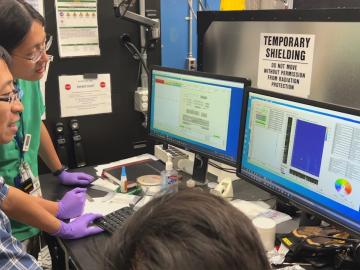
Filter News
Area of Research
News Topics
- (-) Artificial Intelligence (27)
- (-) Cybersecurity (12)
- (-) Emergency (1)
- (-) Neutron Science (42)
- (-) Quantum Science (12)
- (-) Security (10)
- (-) Transportation (25)
- 3-D Printing/Advanced Manufacturing (26)
- Advanced Reactors (4)
- Big Data (11)
- Bioenergy (25)
- Biology (30)
- Biomedical (12)
- Biotechnology (6)
- Buildings (14)
- Chemical Sciences (24)
- Clean Water (6)
- Composites (9)
- Computer Science (39)
- Coronavirus (4)
- Critical Materials (10)
- Education (3)
- Energy Storage (23)
- Environment (49)
- Exascale Computing (16)
- Fossil Energy (2)
- Frontier (19)
- Fusion (13)
- Grid (19)
- High-Performance Computing (33)
- Hydropower (3)
- Irradiation (2)
- Isotopes (17)
- Machine Learning (15)
- Materials (59)
- Materials Science (26)
- Mathematics (2)
- Mercury (5)
- Microelectronics (2)
- Microscopy (12)
- Molten Salt (5)
- Nanotechnology (16)
- National Security (21)
- Nuclear Energy (31)
- Partnerships (24)
- Physics (23)
- Polymers (9)
- Quantum Computing (12)
- Simulation (29)
- Software (1)
- Space Exploration (6)
- Summit (11)
Media Contacts

The Spallation Neutron Source — already the world’s most powerful accelerator-based neutron source — will be on a planned hiatus through June 2024 as crews work to upgrade the facility. Much of the work — part of the facility’s Proton Power Upgrade project — will involve building a connector between the accelerator and the planned Second Target Station.

ORNL hosted its annual Smoky Mountains Computational Sciences and Engineering Conference in person for the first time since the COVID-19 pandemic.

The Department of Energy’s Oak Ridge National Laboratory hosted its Smoky Mountains Computational Science and Engineering Conference for the first time in person since the COVID pandemic broke in 2020. The conference, which celebrated its 20th consecutive year, took place at the Crowne Plaza Hotel in downtown Knoxville, Tenn., in late August.

Quantum computers process information using quantum bits, or qubits, based on fragile, short-lived quantum mechanical states. To make qubits robust and tailor them for applications, researchers from the Department of Energy’s Oak Ridge National Laboratory sought to create a new material system.

Carl Dukes’ career as an adept communicator got off to a slow start: He was about 5 years old when he spoke for the first time. “I’ve been making up for lost time ever since,” joked Dukes, a technical professional at the Department of Energy’s Oak Ridge National Laboratory.

Tom Karnowski and Jordan Johnson of ORNL have been named chair and vice chair, respectively, of the East Tennessee section of the Institute of Electrical and Electronics Engineers, or IEEE.

Neutron experiments can take days to complete, requiring researchers to work long shifts to monitor progress and make necessary adjustments. But thanks to advances in artificial intelligence and machine learning, experiments can now be done remotely and in half the time.

Subho Mukherjee, an R&D associate in the Vehicle Power Electronics Research group at the Department of Energy’s Oak Ridge National Laboratory, has been elevated to the grade of senior member of the Institute of Electrical and Electronics Engineers.

A new nanoscience study led by a researcher at ORNL takes a big-picture look at how scientists study materials at the smallest scales.

Mike Huettel is a cyber technical professional. He also recently completed the 6-month Cyber Warfare Technician course for the United States Army, where he learned technical and tactical proficiency leadership in operations throughout the cyber domain.


